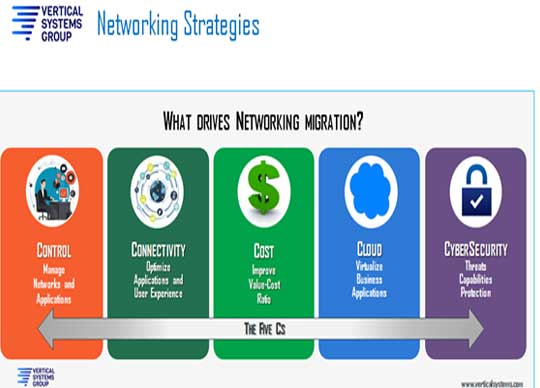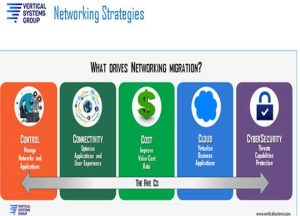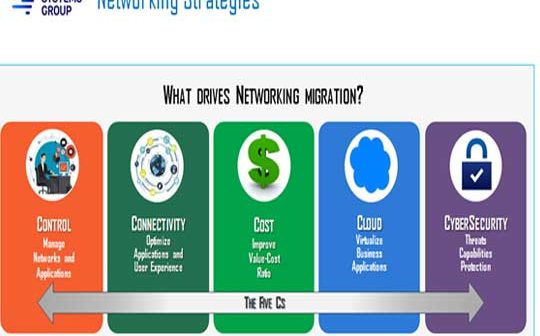
By Guy Matthews, Editor of NetReporter

Figure 1 – The five Cs of network migration
Innovation is at the heart of business transformation, especially when applied to network technologies and strategies. Efforts made in this area will be rewarded by enhanced competitive edge and a brighter commercial outlook in troubled and uncertain times.
So goes the theory. It’s the practical reality of keeping up the momentum of all this innovation and transformation that’s the challenge, says Erin Dunne, Director of Research Services with independent analyst firm Vertical Systems Group.
Dunne summarises the challenge in her ‘five Cs’ of networking migration. First there’s the business of control over networks and applications. Then there’s the connectivity needed to optimise those applications as well as the user experience. Cost must be aligned with value. The cloud is where applications are virtualised. And lastly cybersecurity cannot be ignored if good work in the other areas is to be properly protected. But if Dunne could choose just one of the Cs as paramount? Cloud, she says, is where successful migration originates. That’s where transformation stands or falls.
“Application traffic, as we know, is much more dynamic these days,” she notes. “It’s more real-time, and demands better network management capabilities, design, optimization and analytics. You need the right SLAs, and orchestration too, to be able to control all that.”
It’s not so much the traffic that needs to change as the networks that it rides on, she adds: “Without the network, everything else is compromised.”
To broaden the conversation, Dunne called on a panel of leading names from across the CIO and cybersecurity ecosystem. Ravi Malick is Global Chief Information Officer with Box Inc, a developer of cloud-based collaboration tools. He says innovation is core to what Box Inc does: “It’s probably one of the biggest aspects of the value that we can provide to our customers,” he claims. “I think there’s an expectation that we’re going to constantly innovate and continually invest in our core product offering. A recent example of that is how we’re innovating around digital signatures. Content is another area we want to manage in a digital and automated way.”
Tata Communications recently conducted a global C-level survey, polling around 750 organizations across 11 countries, looking at their progress towards digital transformation and the maturity of their digital platform deployment.
“We classified them into three distinct categories,” explains Amit Sinha Roy, Vice President, Global Head of Marketing & Communications with the company. “There are the Digital Trailblazers on top, the Digital Migrators in the middle, and the Digital Aspirants who are at the start of the process. Of the enterprises we surveyed, 90% are yet to achieve their digital goals.”
The most pressing problem that Tata uncovered, he says, is probably cybersecurity: “There are other issues too,” he notes. “Almost half of respondents attributed productivity loss during the crisis to their connectivity and another half talked about fear of employee burnout without the right tools and platforms and systems to help. Almost 40% cited the threat of losing market share if they didn’t shift to a digital-first operating model. It’s only the 10% of Trailblazers, the enterprises with the most advanced digital operating models, who were able to grow during the crisis. The Migrators are hanging in there, and the Aspirants have lost market share.”
Katrina Redmond is Senior Vice President and Chief Information Officer with power management specialist Eaton. She describes herself as taking a practical approach to the issue of transformation: “My priority is things like internal productivity, and the sun setting of old apps, trying to figure out a way to displace older legacy technologies with more contemporary ones. The cost component of that, as well as the sheer productivity drain that an organization suffers when they’re trying to go through that process, means we’ve simply got to be able to innovate. It’s about how we work internally in order to take advantage of some of the more cutting edge technologies.”
Atif Khan is CTO and Founder of networking as a service provider Alkira. From his perspective, the main innovations that need to are on the networking side: “We have realized that networks cannot be built the same way they were built five years ago or 10 years ago, because of the way cloud is being adopted by enterprises,” he comments. “You cannot keep building networks outside the cloud the way we were doing it. Cloud provides all these resources and capabilities to do different things at a much faster pace, so networks must now move as fast as applications. When it comes to development and implementation deployment, the network has been lagging. Tons of innovation is required there.”
With regards to networking technologies and strategies, Amit Sinha Roy of Tata Communications thinks the future lies in bringing in more controllable capabilities, whether for bandwidth or on-demand policy changes through SD-WAN. “It’s also about being able to have composable networks,” he adds. “With security within the network, along with intelligence in the overlay, which could be intelligent routing. In the underlay it could be AI or ML based fault resolution. And then we have SASE to bring in some network security convergence, which can be achieved by deploying evolved underlay and overlay capabilities. As part of the underlay capabilities there is the core data network, which could be MPLS. And then there is the Internet. The core network needs to be more programmable.”
Khan of Alkira believes agility and simplification should be prioritized: “I should be able to build my network on demand,” he claims. “Why do I have to go and spend days or months figuring out how to build my network? It’s just not moving at the speed of the application. And it’s a big limitation in this day and age. Agility and simplification in networking will take us a long way, that and being able to consume networks as a service.”
Tom Bianculli, Chief Technology Officer with enterprise mobile computing specialist Zebra Technologies sees the transformation issue through the eyes of his customers, who are spread across several verticals: “The conversation has really accelerated around what we would call the node, meaning let’s say the warehouse or the distribution center of a retail chain,” he says. “We’re looking at how you optimize the workflow, the picking, the packing, the shipping and sorting. Then it’s about optimizing that supply network so you’re not just looking at one node but all the nodes across the supply chain. How do you optimize that end-to-end as a network? That’s about the control, the connectivity, the cost, the security wrapped around that. To optimize the network we’ve got to aggregate data from all nodes, from the transportation between the nodes, from the worker at the edge and put into place a framework.”
Redmond of Eaton also has the issue of a disparate geography, with over 600 locations spread across the globe: “The challenges that we face, country by country, are different,” she says. “There are a lot of connectivity challenges in this space, and a lot of cost. So how do we solve it in a cost-attractive way? Part of that is trying to roll back some legacy approaches, and bring in speed and flexibility for our particular circumstances in an industrial environment. If we could even do half of what we want, it’s a game changer. Wherever we can find innovations and we take advantage of those, we’re all for it.”
Amit Sinha Roy of Tata Communications concludes with a consideration of how AI is coming into the network, and the challenges and benefits that brings: “There is the perception that AI takes away jobs, and in some cases it does indeed do that,” he notes. “It is also becoming intrusive in some people’s eyes. But it can generate so much efficiency as well. The gains are tremendous when it is deployed for automating, or to assist the human element. AI also helps with understanding what’s happening in the network in real time, so you can actually have self-healing networks, diagnosing the root cause, and enabling faster incident resolution. All this adds up to a better network experience which is the kind of evolution and transformation that we’re all talking about.”
Featured Speakers:
 Analyst Chair: Erin Dunne, Director of Research Services, Vertical Systems Group
Analyst Chair: Erin Dunne, Director of Research Services, Vertical Systems Group
www.verticalsystems.com
 Atif Khan, CTO and Founder, Alkira
Atif Khan, CTO and Founder, Alkira
www.alkira.com
 Ravi Malick, Global Chief Information Officer, Box Inc
Ravi Malick, Global Chief Information Officer, Box Inc
www.box.com
 Katrina Redmond, Senior Vice President and Chief Information Officer, Eaton
Katrina Redmond, Senior Vice President and Chief Information Officer, Eaton
www.eaton.com
 Amit Sinha Roy, Vice President, Global Head of Marketing & Communications, Tata Communications
Amit Sinha Roy, Vice President, Global Head of Marketing & Communications, Tata Communications
www.tatacommunications.com
Tom Bianculli, Chief Technology Officer, Zebra Technologies
www.zebra.com
Link to the ‘Innovative networking strategies to accelerate your competitive edge’ webcast: https://www.businessinnovationleadersforum.org/events/innovative-networking-strategies-to-accelerate-your-competitive-edge/





